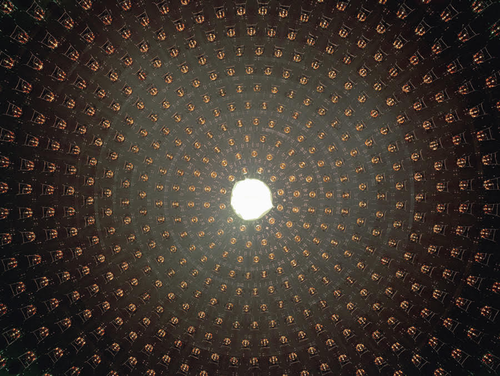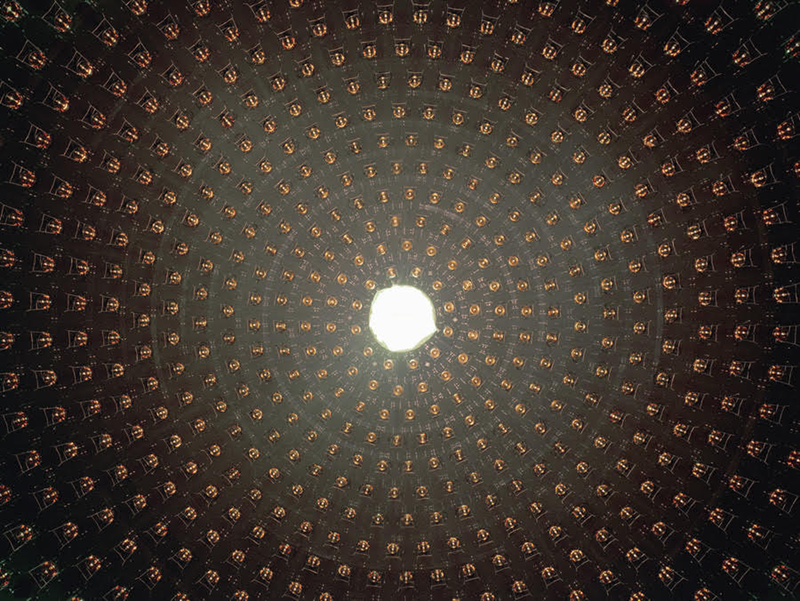Neutrinos with a Single Energy
Neutrinos are not the easiest particles to work with. Physicists study their rare interactions with other particles in large detectors but can’t control the neutrinos’ incoming energy. The MiniBooNE Collaboration at Fermilab has now shown how to sidestep this problem by using neutrinos that all have the same initial energy. These neutrinos could act as precision probes of interactions involving the weak nuclear force and may provide a definitive answer to the long-standing question of whether so-called sterile neutrinos exist.
The MiniBooNE experiment at Fermilab is one of many that are studying neutrino oscillations, the transformation of one kind of neutrino into another. Specifically, it’s looking at the conversion of muon neutrinos into electron neutrinos as they travel the 500-meter distance from the source to the detector, which is a large sphere containing 800 tons of mineral oil and over 1000 photodetectors.
One of the main uncertainties for MiniBooNE and similar experiments is the energy of the incoming neutrinos. Researchers can indirectly measure this energy by adding up the energies of the outgoing particles, but these estimates are not always accurate—nuclear effects and missing particles can add uncertainty. However, certain particles, such as kaons, produce “standard candle” neutrinos that have a fixed energy. Kaons decay about 64% of the time into a muon and a muon neutrino, and if the kaon is at rest, then the neutrino will always have an energy of 236 MeV. This “kaon decay at rest” or “KDAR” neutrino is the only standard candle available with energy above 100 MeV.
The MiniBooNE Collaboration recently realized that a source of KDAR neutrinos was right next door: Fermilab’s NuMI beamline produces neutrinos for other experiments and in the process creates KDAR neutrinos. “This is really just a happy coincidence,” says Joshua Spitz from the University of Michigan in Ann Arbor, a member of the MiniBooNE team.
When high-energy protons strike the metal and concrete “absorber” at the end of the NuMI beamline, they produce kaons that scatter around in the absorber material and eventually come to rest and decay. “MiniBooNE sees a relatively high flux of KDAR neutrinos because it sits close to the NuMI absorber, only 86 meters away,” says Spitz.
A KDAR neutrino reaching the MiniBooNE detector can interact with a carbon nucleus within the mineral oil, creating a muon that is detected by the flash of light it generates. The challenge is that other (non-KDAR) neutrinos also reach MiniBooNE from the NuMI beamline, and these background neutrinos also create muons. To separate the KDAR signal from the background, the MiniBooNE team used timing data, as the KDAR neutrinos arrive slightly later, with respect to each pulse of the NuMI beam, than non-KDAR ones. Combining this technique with some additional modeling, the team was able to identify about 3700 KDAR neutrino events. They measured the energy transferred to the nucleus for each event and plotted the likelihood (cross section) for neutrino-nucleus interactions at each value of energy transfer, data that can be compared with predictions from nuclear models.
“Isolating the KDAR signal from the large neutrino background is very challenging, and the MiniBooNE Collaboration used several very clever ideas in their analysis,” says high-energy physicist Or Hen from the Massachusetts Institute of Technology in Cambridge. He says that KDAR neutrinos can be used to improve our understanding of neutrino-nucleus interactions. Neutrino expert Kate Scholberg from Duke University, North Carolina, agrees. “We don’t understand very well exactly what happens to a nucleus when you bash it with a neutrino of a few hundreds of MeV,” she says. “But with a KDAR neutrino interaction, you know exactly what energy went in, so you have a clean handle on the nuclear response.”
The MiniBooNE Collaboration writes in Physical Review Letters that in the future, KDAR neutrinos could be used as a unique probe of the nucleus. Neutrinos are neutral and interact exclusively through the weak nuclear force, so they might reveal information—such as the strange quark content of the nucleus—that is usually overwhelmed in the data by the stronger electromagnetic effects. Scholberg says that KDAR neutrino studies will be especially important in interpreting data from future oscillation experiments (such as the Deep Underground Neutrino Experiment and Hyper-Kamiokande), where researchers will try to fill in the final pieces of the neutrino picture. She also imagines KDAR neutrinos being used directly in an oscillation experiment that monitors the particles to see if any “disappear” by transforming into sterile neutrinos, hypothetical particles that don’t interact with matter.
This research is published in Physical Review Letters.
Correction (10 April 2018): We have revised this story to clarify that, in addition to demonstrating a new tool for future measurements, the authors also reported in this paper that they used KDAR neutrinos to make a nuclear measurement.
–Michael Schirber
Michael Schirber is a Corresponding Editor for Physics Magazine based in Lyon, France.





